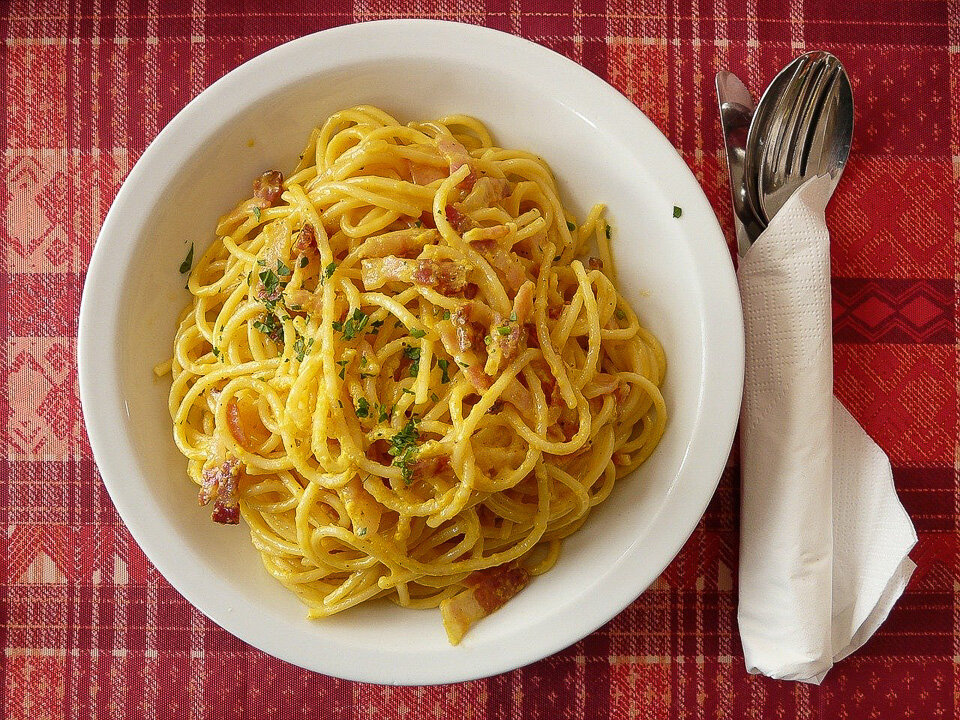Eat Like a Local in Rome: 14 Roman Dishes to Eat in Italy’s Eternal City
Food in Italy is some of the best in the world, and what’s typically Italian food in one region may be wildly different from what’s eaten an hour away. Italian food is regional, and the local food in Rome is certainly no exception.
Roman cuisine in the Eternal City is a beacon of simplicity. It pays homage to its peasant roots, creating vibrant dishes out of a few ingredients.
Crafting remarkably flavorful meals with such simple combinations is no small feat. Yet, the Romans manage to balance it all beautifully.
From the best pasta in Rome and the unique Roman pizza to street food in Rome, it’s easy to eat your way through the country’s capital city.
So with so many choices and so little time, we thought we’d help get you started. Prego!
Here are 14 Roman dishes and foodie favorites to help you eat like a local in Rome on your next trip to Italy’s Eternal City.
14 Must-Try Roman Dishes
1. Cacio e Pepe
No Roman food guide would be complete without this quintessential dish. Cacio e Pepe literally means cheese and pepper and is one of our all-time favorite meals.
Made from only two main ingredients, this cheesy dish couldn’t be more simple.
Pecorino Romano cheese and black pepper (and maybe a hint of butter) whisked together with a bit of pasta water, it is the hallmark of simplistic cooking.
It’s simple to prepare but exceptionally difficult to prepare well.
Achieving the precise proportions to balance the creaminess of the cheese with the spice of the pepper is a delicate dance, and the Romans have been doing it well for centuries.
Don’t believe us? Try making it at home, but be prepared for months of refining the recipe to get it just right).
The heavenly sauce is usually mixed with a long fresh pasta, such as tonnarelli (thick square spaghetti) or bucatini (hollow spaghetti).
>>> Want to Taste the Best of Rome? <<<
Try this 3.5 hour Gourmet Food Tour of Rome's trendy Trastevere neighborhood — this tour is always capped at 12 people to keep it nice and small! And you’ll taste Rome’s most traditional old recipes at a half dozen stops!
2. Carbonara
There are literally dozens of famous Italian pasta dishes, but none as famous as Carbonara!
The dish is known to have originated in Rome, the exact story is unclear.
Some sources say that it got its start from coalminers, or carbonai, working outside of the city for months on end with only cheese, bacon, and eggs. Still others argue that it was born out of the rations of American GIs during World War II.
No matter how it got started, there’s no denying that it’s simple, delicious, and classically Roman.
Surprisingly, the rich and creamy sauce does not contain an ounce of cream.
The only ingredients are eggs, Pecorino Romano and Parmigiano Reggiano cheese, guanciale (pork cheek) or pancetta (pork belly), tossed with some fresh spaghetti or rigatoni cooked al dente.
As with many Italian recipes, the true measure of a dish is in the quality of its ingredients.
Most chefs will agree that guanciale, with all its fatty goodness, is the protein of choice if you can get your hands on it.
3. Pizza al Taglio
We’re not talking about the pillowy, wood-fired, eat-with-a-fork foodie favorite from Naples.
Pizza al taglio, or “pizza by the slice,” is a category all its own in Rome.
It’s Italian street food-style pizza and an absolute must-try on your visit to the Eternal City.
This kind of pizza is baked in large trays, sliced into squares, and served on paper ready to be devoured.
From simple toppings such as tomato and parsley to elaborate pairings like pumpkin, mozzarella, and pancetta, the possibilities are endless.
For the best experience, we recommend ordering a variety of slices. You’ll pay by the kilo – and we don’t think you can go wrong.
4. Saltimbocca
If you’re in town, this is one dish worth seeking out. You can find it served all over Rome as a popular secondi piatti, usually alongside some fresh green veggies.
Tender slices of veal are wrapped in prosciutto and pounded, then stuffed with fresh sage leaves.
The meat is then sautéed in a beautiful white wine sauce to create a culinary masterpiece that truly, as the name saltimbocca implies, “jumps in your mouth.”
5. Supplì
This favorite Roman street food is also one of the most popular street foods in Italy!
It’s a must-try snack whether you’re on the go or just looking for a small bite as you explore the city.
The hearty mixture of rice and ragu sauce gets its name from the French word for surprise, after its delightfully surprising center of mozzarella cheese.
All this is dipped in egg, breaded, and deep fried to perfection.
In the past, vendors would walk around the streets at night selling their piping hot supplì to passerby.
Today, you can find them at virtually any deli or pizza joint in Rome.
6. Artichokes
If you’re lucky enough to visit Rome in the winter or spring, you will find this vegetable everywhere!
Artichokes, or carciofi, have two popular preparations – Carciofi alla Romana (Roman-style) and Carciofi all Guidìa (Jewish-style) – and you can find both on just about every menu in town.
Carciofi alla Romana
Roman-style artichokes are rounder and less thorny than most other varieties.
They’re stuffed with an herb mixture of garlic, mint, and parsley and braised upside down until soft all the way through.
You’ll find some variations with a bit of lemon juice drizzled on top.
The end result is delicate, buttery, and melts in your mouth.
This type of preparation makes for the perfect side dish to any Roman meat entrée.
Carciofi alla Guidìa
Jewish-style artichokes date back to the 16th century, when Roman Jews were forced to live inside the confines of a ghetto.
Behind those walls emerged a culinary symbol that has become so intimately tied to Rome and Jewish culture today.
The process begins with preparing the artichokes, which involves removing the outer leaves and trimming the vegetable to look like a rose.
Then, the plant is deep fried until golden brown and drained on a paper towel.
The leaves are opened up by whacking two plants together and placed back in the oil for a second frying.
The result? Crispy, potato chip-like leaves on the outside and a heart that is tender. The contrast in texture is truly out of this world.
Carciofi alla guidìa are best enjoyed in season from February to May, and some of the most delicious can still be found in the Jewish quarter.
>>> Taste Your Way through Rome’s Jewish Quarter! <<<
Try this 3 hour Tasting Tour with a Local Guide. From the wine and architecture to fresh pasta and espresso, this is a fantastic food tour of Rome!
7. Gelato
Yes, it’s true that you’ll find the best gelato Italy has to offer in Sicily. However, that doesn’t mean there aren’t plenty of rival gelateria in Rome!
No trip to the Eternal City would be complete without indulging your sweet tooth.
And while gelato parlors may be a dime a dozen around the city’s streets, here’s a tip for scouting out the best ones: avoid colors that are too good to be true.
Bright shades are usually indicative of lots of artificial colorings and flavorings. The authentic gelato is are generally less neon and more flavor!
Enjoy your gelato with a coffee drink or espresso, and always a glass of water.
8. Bucatini all’Amatriciana
This dish is just one of the many examples of Roman cuisine where simple ingredients coalesce to create something remarkable.
Guanciale (pork cheek), Pecorino Romano cheese, tomatoes, and some hot peppers are all that’s needed to make the sauce. No garlic, onion, or herbs involved.
Because of this, the flavors are quite different than many other Italian pasta dishes. The spiciness of the pepper compliments the saltiness of the cheese beautifully.
All this is tossed with some hollow bucatini pasta to give that extra bit of “bite” compared to traditional spaghetti.
Pair with a glass of red wine (and don’t forget to slurp up the sauce!) for a meal you won’t soon forget.
9. Trapizzini
Romans love their street food, and Trapizzino is a foodie favorite.
The name combines the words “pizza” and “tramezzino” – and that’s exactly what it is – a pizza-sandwich!
What began as a novelty is now one of the most popular street items around.
In fact, it’s even made its way to locations in New York and Tokyo.
So what is a pizza-sandwich? A fluffy, triangular wedge of pizza dough sliced down the center to create a pocket, then stuffed with anything from meatballs to artichokes to eggplant parmesan. Sign me up!
>>> This popular street food tour in Rome is also one of Viator’s best-selling tours. <<<
The 2.5 hour tour lets you try local delicacies such as supplì, cured meats, pizza and gelato, as well as typical seasonal dishes from Rome’s Jewish Quarter. Then you’ll wash it all down with some wine and beer! <<<
10. Maritozzi
This classic pastry has a long (and romantic) history and is a staple in cafes and espresso bars throughout Rome.
It derives its name from the Italian word for “husband” in reference to Roman suitors proposing to their future brides on the 1st of March with a ring buried inside a maritozzo.
Today, it’s unlikely that you’ll break your tooth on one ;-)
The sweet dough-based bun may be sliced in half and filled with fresh panna (whipped cream) or speckled with chocolate chips. Some restaurants even offer a few savory varieties on their menus.
While maritozzi are traditionally eaten for breakfast, they may also be enjoyed as a hearty snack or dessert any time of day.
Enjoy with espresso for a match made in heaven.
11. Pizza Romana
Pizza in Italy is one food that you’ll be dreaming about for weeks — years — to come. Just thinking about it has me salivating!
It is so different from pizza served in the U.S. It’s lighter, tastier, and always made with the freshest ingredients.
And while you’ll find it all throughout Italy, the style varies from place to place. There are two distinct varieties: Neapolitan-style and Roman-style pizza.
Which is better? Well, that’s hotly debated.
Naples is the very birthplace of pizza. Dough is still made from only flour, yeast, water and salt, forming a crust that’s fluffy and thick.
The pizza is rather small (you don’t need a lot – it’s filling!) and toppings tend to be clustered in the center.
Roman-style pizza is made with the same ingredients plus oil. The addition of olive oil makes for a lighter crust that can be stretched much thinner than the Neapolitan variety.
The pizza itself is bigger and crisps up beautifully in the oven.
Choose from pies topped simply or covered in practically any topping imaginable.
12. Pasta alla Gricia
Out of all the powerhouse pasta dishes in Rome, this one is perhaps the most overlooked.
Similar to Cacio e Pepe, two simple ingredients combine to make the mouthwatering sauce: Pecorino Romano cheese and guanciale, or pork cheeks.
The guanciale is really the star of the show, because it’s the fat that provides all the flavor.
Starchy pasta water is then whisked in to create a beautiful emulsified sauce. It’s typically used to glaze bucatini or spaghetti, although rigatoni is common in this hearty dish as well.
You might think Carbonara and Cacio e Pepe are the only pastas to try in Rome, but keeping an eye out for Pasta alla Gricia is one of the most important Rome travel tips of all!
13. Porchetta
This famous deboned pork roast hails from central Italy and is one of the most popular delicacies in Rome.
It’s one of those food items that’s uniquely regional, and the exact recipe for seasoning varies from place to place.
Despite these variations, the meat is always slow roasted for several hours.
The cooking process is crucial, as roasting too quickly can cause the meat to dry out.
The finished product is crispy on the outside yet tender on the inside – perfect on its own or in sandwiches.
You’ll fnd it at almost any deli, market, or food truck in Rome.
14. Coda alla Vaccinara
This traditional Roman stew is made from the tail of the ox.
Sound a little strange? That’s because it was historically a poor man’s dish.
The particular cut was once considered a “fifth quarter,” all that was left of the meat after the wealthy made their prime selections.
It would then be sold to local osterias, who would turn it into a remarkable meal for an affordable price.
Today, you’ll still find oxtail stew braised and simmered with delicious prosciutto ham, wine, tomato, and veggies.
Have you visited the Eternal City? What were your favorites foods in Rome?

















